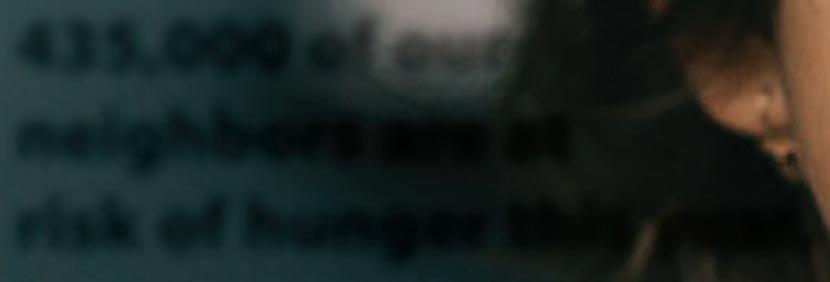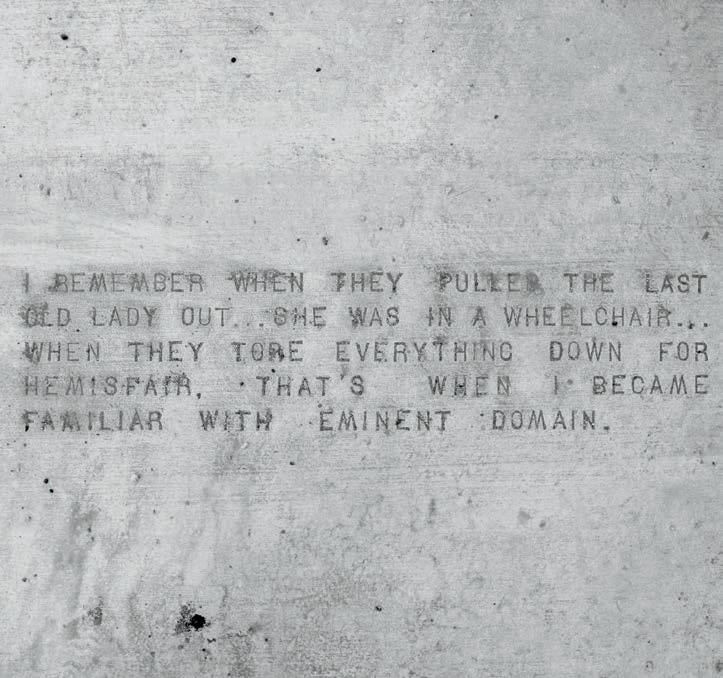
8 minute read
Feature
Smoking Gun
A study shows Bexar County has the state’s second-highest number of offi cer-involved shootings. Black residents are disproportionately in the crosshairs.
Advertisement
BY SANFORD NOWLIN
Offi cer-involved shootings of civilians in Bexar County were the second highest of any county in the state from 2016-2019, and their frequency increased in three of those four years, according to a new report by the nonprofi t group Texas Justice Initiative.
What’s more, while more white people were shot by law enforcement offi cers in Bexar County during that time, Black people were both shot and killed at a disproportionate rate, according to the data, which was culled from reports fi led with the Texas Att orney General’s Offi ce.
TJI’s report comes amid a nationwide reckoning on police reform and racial justice with activists calling out departments for disproportionate use of force that targets people of color.
Such issues came into even sharper focus locally when a Bexar County Sheriff ’s deputy on August 25 shot and killed former Army sergeant Damian Lamar Daniels, a 30-year-old Black man, as deputies tried to detain him for mental health treatment. John A. Rodriguez, the deputy who fi red on Daniels, also shot and killed another person 10 years prior who was suffering a mental health crisis, an Express-News investigation revealed.
The same day as Daniels’ shooting, San Antonio Police Department offi cers wrestled Black jogger Mathias Ometu into the back of a squad car on an incorrect suspicion that he was a domestic violence suspect.
“When I look at the data in this report, my deepest suspicion — and probably my deepest fear — is that we’re seeing a cultural problem inside police departments,” said Gerald Reamey, a St. Mary’s Law School professor who tracks policing issues. “It’s troubling that we’re seeing so many of these incidents in Bexar County.”
Big Numbers, Big Disparity
The data broken out in TJI’s report includes both numbers from each county’s sheriff ’s offi ce plus every police department operating there, off ering an overview of big-city, rural and suburban departments.
A total of 72 civilians were shot by sworn law offi cers in Bexar over the previous four years, and 2019 marked the only one of those years that offi - cer-involved shootings decreased, falling to 19 from 20 the prior year. Of that total, 38 of the civilians shot — more than half — died of their wounds.
Statewide, the total number of civilians shot during
Jaime Monzon
offi cer-involved incidents increased between 2016 and 2019. At the same time, the survival rate of those shot decreased, according to TJI’s analysis.
The data also shows that Black people made up a disproportionate percentage of the civilians shot by police in Bexar over that time, accounting for 13.9% of the total, even though they make up just 7.3% of the county’s population, according to U.S. Census data.
In contrast, Hispanic people made up 59.7% of the total number of civilians shot, roughly equivalent to the 60.3% they make up of the overall population. Whites made up just 22.2% of those shot, while they account for 27.3% of the overall population.
On that front, Bexar’s statistics mirrored that of other big Texas cities, according to TJI. Black civilians were overrepresented in offi cer-involved shooting incidents in each of the fi ve most populous counties.
Data and Facts
San Antonio police-reform activists say the numbers back up what they have long argued: that Black people are more likely to face violence during encounters with law enforcement. The report, they add, is more evidence that San Antonio must shift funding away from its police department and into social programs.
“This report is not just someone’s opinion or skewed to one side — this is data and facts,” said Ananda Tomas, community organizer for police-reform group Fix SAPD. “It bolsters our argument and shows that something substantial needs to change.”
Valerie Reiff ert, who leads Radical Registrars, a group that works to increase voter registration, said the disparity highlighted in the report is evidence of systemic racism in police departments. Those struc
tural issues can’t be solved through minor reforms, she said — communities need to rethink law enforcement from the ground up.
“Black people are unsafe in our own city because of how they’re treated during police interactions,” she said. “I don’t know what could make it any clearer than the recent incidents involving Sgt. Daniels and [Mathias Ometu],” she added.
Picking Apart the Numbers
TJI’s study doesn’t off er critiques of policing practices, nor does it lay blame for the rise in offi cer-involved shootings. However, TJI Executive Director Eva Ruth Moravec said the trends it highlights should drive analysis and debate by policymakers, citizens and law enforcement offi cials.
“It shows that, unfortunately, these numbers haven’t slowed down,” said Moravec, who covered criminal justice in Texas for more than a decade in the media, including a stint at the Express-News. “That’s why it’s important to collect this data, to analyze it, to pick it apart and discuss it.”
Bexar County Sheriff Javier Salazar said the numbers in the report don’t necessarily indicate local law enforcement offi cials are too quick to shoot, adding that crime trends and demographic factors also drive up a county’s numbers.
Even so, he said he’s taking note.
“Any time an organization is willing to crunch the numbers and do a deep dive into the data, it would be irresponsible for us not to look and see what we can glean,” Salazar said. “I’m asking my folks to look at the report and see what we can pull from it.”
When reached for comment by the Current, an SAPD spokeswoman said no one was available for an interview on the study. Instead, she provided an online link to the department’s fi lings with the AG’s offi ce.
Use of Force
Reamey of St. Mary’s said a shift in police culture since the 1980s has likely contributed to Texas’ rise in offi cer-involved shootings. In addition, the departments’ purchases of heavier fi repower and high-capacity magazines have made shootings more deadly for civilians.
“Between the early 1980s and now, police have adopted this belief that failure to comply is a capital off ense — if you don’t comply, you could be killed or at least taken down,” said Reamey, who spent nearly three decades off ering legal training for police departments. “That’s a very fatal fl aw when you’re trying to deal with the public.”
The incident with Ometu, the Black jogger, ended with Bexar County DA Joe Gonzales dropping the felony assault charges fi led against him for allegedly kicking offi cers when they forced him into the patrol vehicle. However, Reamey said the interaction could have taken a lethal turn.
“Once offi cers start on the path to escalation, the logical conclusion very often is deadly force,” he added.
On at least one front, there has been some improvement in the way local law enforcement interacts “In a situation where you know someone is armed with the public, experts point out. SAPD has revised or could be more dangerous than most, you can’t just the way it addresses mental illness, including crisis send in a mental health worker,” Salazar said. “You intervention training for could end up with a dead all cadets and establishmental health worker or ing a special unit to dia hostage situation.” vert people to treatment Even so, Salazar said instead of jail. increased training, in
Even so, Moravec said cluding in de-escalation introducing guns into tactics, can help reduce situations where somethe number of offi cer-inone is suff ering a breakvolved shootings. down can be a recipe for To that end, he doudisaster. That argument bled the number of is echoed by local poin-service training hours lice-reform activists who required of his deputies call for shifting police after becoming sheriff , funding into mental raising the total to 40 a health programs. year. He also instituted a
“I know San Antonew ethics policy, which nio has done a lot for extends to the handling homelessness and mental of calls, and has put more illness and gott en accofocus on the mental lades for that,” Moravec health of his deputies. said. “But there’s still a However, police-relot of discussion about form activists say trainwhether when someone ing won’t solve the probis having a mental health lem if it doesn’t change crisis the best person offi cers’ mindsets. to go out on that call is Part of the problem, someone with a weapon. In some of these cases, what ends up happening M Twitter / S. Lee Merritt Army veteran Damian Lamar Daniels was shot and killed by a Bexar County they argue, is that cops have been conditioned to see violence as a key tool is suicide by cop.” sheriff ’s deputy late last month. at their disposal. “I don’t care how much
More Training? training [a department] requires for its offi cers, the training is part of the
Sheriff Salazar declined to discuss specifi c details problem,” Tomas of Fix SAPD said. “It pushes the idea of the Daniels shooting since it’s still under investithat every interaction with the public is a life-orgation. However, he said reducing offi cer-involved death situation, and that isn’t the case.” shootings during mental-health calls isn’t as simple The full TJI study is available for download at the as dispatching social workers instead of cops. organization’s website: texasjusticeinitiative.org.


435,000 of our neighbors are at risk of hunger this year.






